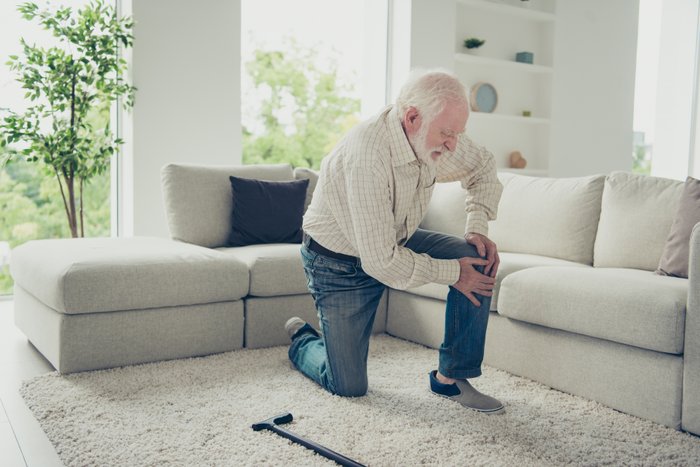
Got weak bones? In the United States, one in two women and one in four men will suffer a bone fracture from osteoporosis over the age of 50. According to the National Osteoporosis Foundation, premenopausal women will need up to 4 cups of milk per day just to prevent and treat osteoporosis. Osteoporosis is a medical condition characterized by weak bones as measured by a bone density scan called dual-energy X-ray absorptiometry (DEXA) scan. The lower the score, the higher the risk. If the score is slightly less than normal, you have osteopenia (weak bones). Lower scores indicate osteoporosis (weaker bones with a higher risk for fractures.)
Once bones break from a fall or trauma, they do not fuse back together. Fractures require surgery where screws are installed to keep the broken bones together. If left untreated, you will experience pain, inflammation, and immobility. Out of the three consequences, immobility is the worst outcome. Immobility can completely change your life. You may require assistance from caretakers, transfer to a nursing home, a walker or electric scooter, and a dramatic reduction in daily activities. To increase bone strength and prevent fractures from weak bones, it is recommended to:
- Ask your physician about the DEXA scan. Central DEXA scans are covered by most insurance companies for all women aged 65 years old or older and women or men with a high risk of developing a fracture within 10 years. The fracture risk comes from the FRAX calculator which is based on risk factors such as drinking 3 servings or more of alcohol daily, being a current smoker, having rheumatoid arthritis, osteopenia, glucocorticoid use, and a history of fractures. Other individuals who qualify for the DEXA scan are those with a history of using DepoProver®, post-menopausal women with fractures, men with hypogonadism, transplant patients, and individuals with co-morbid illnesses that can increase their risk of osteoporosis (dialysis, hyperparathyroidism, low calcium intake, dementia, recent falls, and low physical activity. The scan may be repeated every two years to evaluate treatment outcomes.
- Understand your T-score. The T-score is generated by the DEXA scan. A T-score of -1.0 or higher is normal. A T-score of -1.0 to -2.5 means that you have osteopenia. Individuals with osteopenia should get a DEXA scan every 2 to 5 years, start weight-bearing exercises and consume more calcium and vitamin D. T-score of -2.5 or less means that you have osteoporosis. If osteoporosis is diagnosed, your physician may prescribe drug therapies to increase bone strength such as bisphosphonates, selective estrogen-receptor modulators, and hormonal therapy.
- Eat more calcium-rich foods and take calcium supplements. According to the National Osteoporosis Foundation, the recommended dietary intake for calcium is 1,200 mg/day for post-menopausal women and 1,000 mg/day for men and pre-menopausal women. Since it is difficult to fulfill your calcium requirement through only dietary sources, calcium supplements are recommended. Calcium supplements are available as calcium tablets or in combination with other bone-building supplements. Combination products are preferred because weak bones need three ingredients whether you eat it or take it in pill form: calcium, vitamin D3, and vitamin K. The makers of Joint Health created Vitamin D3 2000 IU, providing all three ingredients in just two tablets daily.
- Boost your vitamin D intake. It is suggested for men less than age 70 and pre-menopausal women to consume 600 units/day of vitamin D. Men ages 70 and up and post-menopausal women have a higher requirement of 800 units. Vitamin D3 2000 IU contains the best and natural form of vitamin D, which is vitamin D3. It is activated in the liver and helps increase the absorption of calcium through the small intestine and kidneys. Vitamin D3 2000 IU has more vitamin D than other combination products. It delivers a whopping 2,000 units of vitamin D while other supplements contain only 400 units.
- Increase your vitamin K intake. Vitamin K is famous for its clotting ability but do you know that Vitamin K also plays a role in bone-building? Bone-building cells secrete osteocalcin, which is embedded into the bone matrix. Production of osteocalcin depends on vitamin K and stimulated by vitamin D. Eating vegetables rich in vitamin K does more than provide clotting factors and support bone deficiency have more vascular calcification or hardening of arteries compared to those without the deficiency. And that's what makes vitamin D3 2000 IU a competitive supplement; it also contains Vitamin K.
- Perform low-impact weight-bearing and muscle-strengthening exercises. Low-impact weight-bearing exercises include elliptical training machines, low-impact aerobics, stair-step machines, and fast walking on a treadmill or outside. Muscle-strengthening exercises or resistance training should also be incorporated. These include lifting weights, using elastic exercise bands, using weight machines, lifting your own body weight, and performing functional movements, such as standing and rising up on your toes. Do not perform heavy lifting or high-impact weight-bearing exercises unless medically cleared by your physician.
It's never too late to start drinking milk, taking calcium tablets, or an all-in-one supplement like Vitamin D3 2000 IU!
If you enjoyed this blog, sign up to receive more articles on health and wellness topics from Sundita's newsletter here. When you sign up, you'll also receive a free downloadable Stress Busting Recipes cookbook!
POPULAR POST
Customer Care
*These statements have not been evaluated by the Food and Drug Administration. These products are not intended to diagnose, treat, cure, or prevent any disease.





